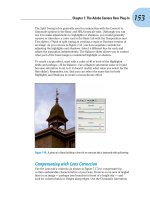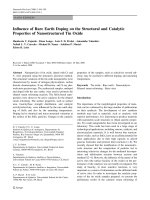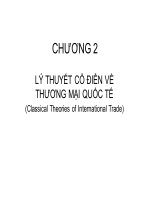Bài giảng Xử lý tín hiệu số: Chapter 5 - Hà Hoàng Kha
Bạn đang xem bản rút gọn của tài liệu. Xem và tải ngay bản đầy đủ của tài liệu tại đây (566.97 KB, 26 trang )
Chapter
p 5
z-Transform
Ha Hoang Kha, Ph.D.Click to edit Master subtitle style
Ho Chi Minh City University of Technology
@
Email:
CuuDuongThanCong.com
/>
The z-transform is a tool for analysis, design and implementation of
discrete time signals and LTI systems.
discrete-time
systems
Convolution in time-domain ⇔ multiplication in the z-domain
Ha H. Kha
2
CuuDuongThanCong.com
z-Transforms
/>
Content
1 z-transform
1.
t
f
2. Properties of the z-transform
3. Causality and Stability
4. Inverse z-transform
Ha H. Kha
3
CuuDuongThanCong.com
Discrete-Time Systems
/>
1. The z-transform
The z-transform of a discrete-time signal x(n) is defined as the power
series:
X ( z) =
∞
−n
x
(
n
)
z
=
∑
x(−2) z − 2 + x(−1) z + x(0) + x(1) z −1 + x(2) z − 2 +
n = −∞
The region of convergence (ROC) of X(z) is the set of all values of
z for
f which
hi h X(
X(z)) attains
i a finite
fi i value.
l
ROC = {z ∈ C | X ( z ) =
∞
∑ x ( n) z
−n
≠ ∞}
n = −∞
The z-transform of impulse response h(n) is called the transform
function of the filter:
H ( z) =
∞
−n
h
(
n
)
z
∑
n = −∞
∞
Ha H. Kha
4
CuuDuongThanCong.com
z-Transforms
/>
Example
Determine the z-transform of the following finite-duration signals
a) x1(n)=[1, 2, 5, 7, 0, 1]
b) x2(n)=x1(n-2)
c) x3(n)=x1(n+2)
d) x4(n)=δ(n)
e) x5(n)=δ(n-k),
(n)=δ(n k) k>0
f) x6(n)=δ(n+k), k>0
Ha H. Kha
5
CuuDuongThanCong.com
z-Transforms
/>
Example
Determine the z-transform of the signal
a)) x(n)=(0.5)
( )=(0 5)nu(n)
( )
b) x(n)=-(0.5)nu(-n-1)
Ha H. Kha
6
CuuDuongThanCong.com
z-Transforms
/>
z-transform and ROC
It is possible for two different signal x(n) to have the same ztransform. Such signals
g
can be distinguished
g
in the z-domain byy their
region of convergence.
z-transforms:
and their ROCs:
ROC of a causal signal is the
exterior
t i off a circle.
i l
Ha H. Kha
ROC of an anticausal signal
is the interior of a circle.
circle
7
CuuDuongThanCong.com
z-Transforms
/>
Example
Determine the z-transform of the signal
x(n) = a nu (n) + b n u (− n − 1)
The ROC of two-sided signal is a ring (annular region).
Ha H. Kha
8
CuuDuongThanCong.com
z-Transforms
/>
2. Properties of the z-transform
Linearity:
if
and
then
z
x1 (n) ←
⎯→
X 1 ( z ) with ROC1
z
x2 ( n ) ←
⎯→
X 2 ( z ) with ROC 2
z
x(n) = x1 (n) + x2 (n) ←
⎯→
X ( z ) = X 1 ( z ) + X 2 ( z ) with ROC = ROC1 ∩ ROC 2
Example: Determine the z-transform and ROC of the signals
a) x(n)=[3(2)n-4(3)n]u(n)
b) x(n)=cos(w0 t)u(n)
c) x(n)=sin(w0 t)u(n)
Ha H. Kha
9
CuuDuongThanCong.com
z-Transforms
/>
2. Properties of the z-transform
Time shifting:
if
then
z
x ( n) ←
⎯→
X ( z)
z
x(n − D) ←
⎯→
z − D X ( z)
The ROC of z − D X (z ) is the same as that of X(z) except for z=0 if
D>0 and z=∞ if D<0.
Example: Determine the z-transform
z transform of the signal x(n)=2nu(n-1).
u(n 1)
Scaling in the z-domain:
z
x ( n) ←
⎯→
X ( z ) ROC : r1 ≤| z |≤ r2
if
then a n x(n) ←
z
⎯→
→ X (a −1 z ) ROC : | a | r1 ≤| z |≤| a | r2
for any constant a, real or complex
Example: Determine the zz-transform
transform of the signal x(n)=a
x(n) ancos(w0n)u(n).
n)u(n)
Ha H. Kha
10
CuuDuongThanCong.com
z-Transforms
/>
2. Properties of the z-transform
Time reversal:
z
x ( n) ←
⎯→
X ( z ) ROC : r1 ≤| z |≤ r2
if
1
1
z
−1
then
x ( − n) ←
⎯→ X ( z ) ROC : ≤| z |≤
r2
r1
Example: Determine the z-transform of the signal x(n)=u(-n).
Convolution of two sequence:
z
z
⎯→
X 1 ( z ) and
x2 ( n ) ←
⎯→
X 2 ( z)
if x1 (n) ←
z
then x(n) = x1 (n) ∗ x2 (n) ←
⎯→
X ( z) = X1 ( z) X 2 ( z)
the ROC is,, at least,, the intersection of that for X1((z)) and X2((z).
)
Example: Compute the convolution of x=[1 1 3 0 2 1] and h=[1, -2, 1] ?
Ha H. Kha
11
CuuDuongThanCong.com
z-Transforms
/>
2. Properties of the z-transform
Differentiation in the z-domain
z
x ( n) ←
⎯→
X ( z)
if
dX ( z )
z
then
nx(n) ←
⎯→ − z
dz
the ROCs of both are the same.
Example: Determine the z-transform
z transform of the signal x(n)=nanu(n).
u(n)
Ha H. Kha
12
CuuDuongThanCong.com
z-Transforms
/>
3. Causality and stability
A causal signal of the form
x(n) = A1 p1n u (n) + A2 p2nu (n) +
will have z-transform
X ( z) =
A1
A2
+
+
−1
−1
1 − p1 z
1 − p2 z
ROC | z |> max | pi |
i
the ROC of causal signals
g
are outside of the circle.
A anticausal signal of the form
x(n) = − A1 p1n u (− n − 1) − A2 p2nu (− n − 1) +
X ( z) =
A1
A2
+
+
−1
−1
1 − p1 z
1 − p2 z
ROC | z |< min | pi |
i
the ROC of causal signals
g
are inside of the circle.
Ha H. Kha
13
CuuDuongThanCong.com
z-Transforms
/>
3. Causality and stability
Mixed signals have ROCs that are the annular region between two
circles.
It can be shown that a necessary and sufficient condition for the
stability of a signal x(n) is that its ROC contains the unit circle.
Ha H. Kha
14
CuuDuongThanCong.com
z-Transforms
/>
4. Inverse z-transform
− transform
x(n) ⎯z⎯
⎯⎯→ X ( z ), ROC
transform
X ( z ), ROC ⎯inverse
⎯ ⎯z -⎯
⎯
⎯→ x(n)
z
x ( n) ←
⎯→
→ X ( z ), ROC
In inverting a z-transform, it is convenient to break it into its partial
fraction (PF) expression form, i.e., into a sum of individual pole
terms whose inverse z transforms are known.
1
Note that with X ( z ) =
-1 we have
1 - az
⎧
a nu (n) if ROC | z |>| a | (causal
(
l signals)
i l)
x ( n) = ⎨ n
⎩− a u (−n − 1) if ROC | z |<| a | (anticausal signals)
Ha H. Kha
15
CuuDuongThanCong.com
z-Transforms
/>
Partial fraction expression method
In general, the z-transform is of the form
N ( z ) b0 + b1 z −1 +
X ( z) =
=
D( z )
1 + a0 z −1 +
+ bN z − N
aM z − M
The poles are defined as the solutions of D(z)=0. There will be M
poles say at p1, p2,…,p
poles,
pM . Then,
Then we can write
D( z ) = (1 − p1 z −1 )(1 − p2 z −1 )
(1 − pM z −1 )
If N < M and all M poles are single poles.
where
Ha H. Kha
16
CuuDuongThanCong.com
z-Transforms
/>
Exampleod
Compute all possible inverse z-transform of
Solution:
- Find the poles: 1-0.25z-2 =0 Æ p1=0.5, p2=-0.5
- We have N
N=11 and M=2,
M 2, i.e., N < M. Thus, we can write
where
Ha H. Kha
17
CuuDuongThanCong.com
z-Transforms
/>
Exampleod
Ha H. Kha
18
CuuDuongThanCong.com
z-Transforms
/>
Partial fraction expression method
If N=M
Wh
Where
and
d
ffor i=1,…,M
i 1 M
If N> M
Ha H. Kha
19
CuuDuongThanCong.com
z-Transforms
/>
Exampleod
Compute all possible inverse z-transform of
Solution:
- Find the poles: 1-0.25z-2 =0 Æ p1=0.5, p2=-0.5
- We have N
N=22 and M=2,
M 2, i.e., N = M. Thus, we can write
where
Ha H. Kha
20
CuuDuongThanCong.com
z-Transforms
/>
Exampleod
Ha H. Kha
21
CuuDuongThanCong.com
z-Transforms
/>
Exampleod
Determine the causal inverse z-transform of
Solution:
- We have
h
N=55 and
d M=2,
2 i.e.,
i N > M. Thus,
Th we have
h
to divide
di id the
h
denominator into the numerator, giving
Ha H. Kha
22
CuuDuongThanCong.com
z-Transforms
/>
Partial fraction expression method
Complex-valued poles: since D(z) have real-valued coefficients, the
complex-valued poles of X(z) must come in complex-conjugate pairs
C id i the
Considering
h causall case, we h
have
Writing A1 and p1 in their polar form, say,
with B1 and R1 > 0,, and thus,, we have
A a result,
As
lt the
th signal
i l in
i time-domain
ti
d
i is
i
Ha H. Kha
23
CuuDuongThanCong.com
z-Transforms
/>
Exampleod
Determine the causal inverse z-transform of
Solution:
Ha H. Kha
24
CuuDuongThanCong.com
z-Transforms
/>
Exampleod
Ha H. Kha
25
CuuDuongThanCong.com
z-Transforms
/>









